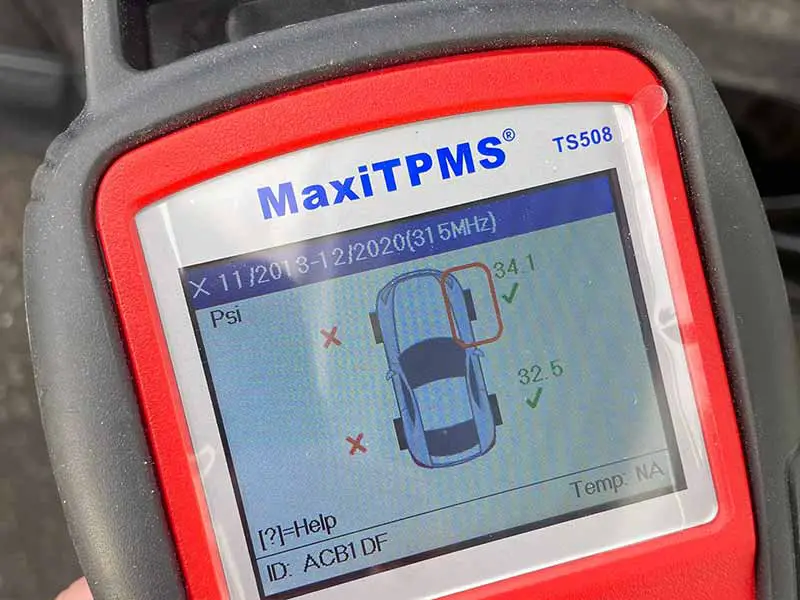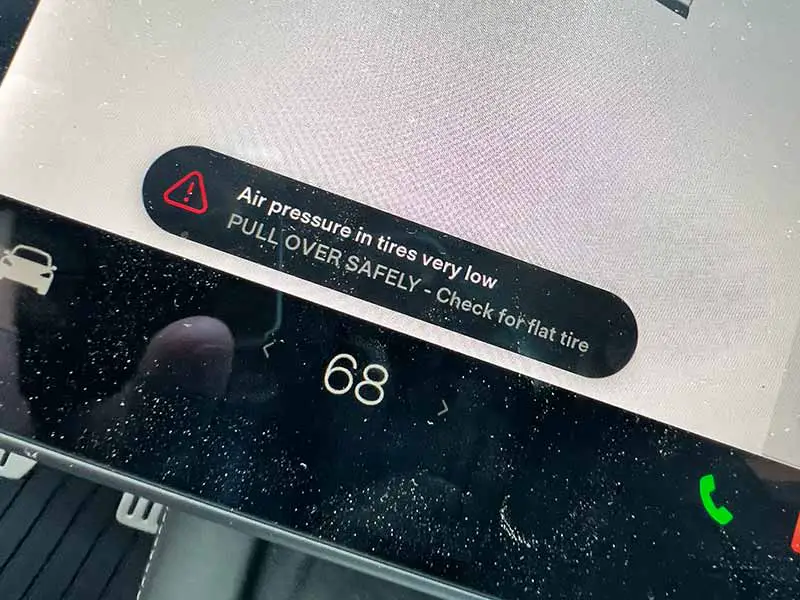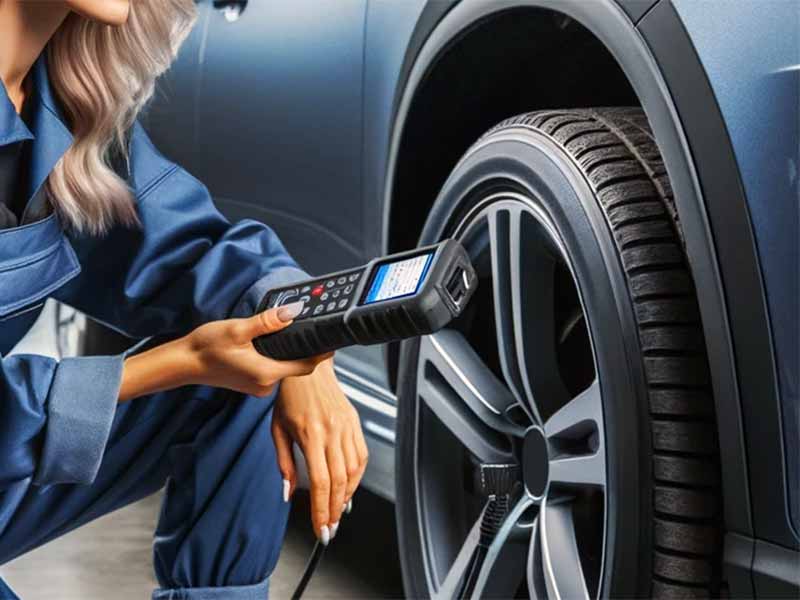Ever rotated your tires or replaced a TPMS sensor and wondered how to ensure your vehicle’s tire pressure monitoring system is still accurate? You’re not alone. Many vehicle owners grapple with the intricacies of TPMS sensors, especially when it comes to relearning them after a rotation or replacement.
How To Relearn TPMS Sensors
Relearning TPMS sensors involves guiding your vehicle’s tire pressure monitoring system to recognize the sensor IDs after events like tire rotation or sensor replacement.Relearning is done with one of 3 main methods: OBD relearn, manual relearn, or auto relearn, depending on the vehicle’s make and model.
In this article, we’ll delve deep into the world of TPMS sensors, exploring the differences between relearning and reprogramming, the nuances of cloning versus reprogramming, and a comprehensive step-by-step guide on the main methods of relearning TPMS sensors.

Autel MaxiTPMS
3 Main Methods of Relearning TPMS Sensors
Ensuring your vehicle’s TPMS system is up-to-date is paramount for safety and performance. When it comes to relearning TPMS sensors, there are several methods available, each with its own set of procedures and applications. Let’s explore these methods in detail.
OBD Relearn
The OBD (On-Board Diagnostics) relearn method involves using a specialized TPMS scan tool that communicates directly with the vehicle’s OBD system.
- Procedure Overview:
Connect the TPMS tool to the vehicle’s OBD port, follow the on-screen instructions, and the tool will relearn the sensor IDs to their respective tire positions. - Advantages:
- Highly accurate and reliable.
- Direct communication with the vehicle’s main system ensures a seamless process.
Manual Relearn
As the name suggests, this method involves manually relearning the TPMS sensors, typically by putting the vehicle in a specific mode and following a set of steps.
- Procedure Overview:
Depending on the vehicle make and model, this could involve a combination of ignition sequences, pedal presses, or using the key fob. Always refer to the vehicle’s manual for precise steps. - Advantages:
- Doesn’t require specialized tools.
- Suitable for vehicle owners who prefer hands-on procedures.
Auto Relearn
This method is the most hands-off, as the vehicle automatically relearns the TPMS sensors over time and during regular driving.
- Procedure Overview:
Simply drive the vehicle for a certain distance or time, and the system will automatically detect and relearn the sensors. - Advantages:
- Hassle-free and requires minimal intervention.
- Ideal for those who prefer a “set it and forget it” approach.

The 3 TPMS Relearn Procedures: A Step-by-Step Overview
Navigating the TPMS relearn procedure can be intricate, but with a clear understanding of the steps involved in each method, you’ll be better equipped to ensure your vehicle’s tire pressure monitoring is accurate.
OBD Relearn:
This method involves direct communication with the vehicle’s On-Board Diagnostics (OBD) system.
- Gather Necessary Tools:
Ensure you have a compatible TPMS scan tool for your vehicle. - Connect to OBD Port:
Locate the OBD port, typically found under the dashboard, and connect the TPMS tool. - Follow On-Screen Instructions:
Power on the tool and select the ‘TPMS Relearn’ option or similar. Follow the prompts provided. - Complete the Procedure:
The tool will guide you through the process, which may involve turning the ignition on/off or pressing specific buttons. - Confirmation:
Once done, the tool should confirm successful relearning. Check the TPMS light on your dashboard to ensure it’s not blinking or staying on.
Manual Relearn:
A more hands-on method that involves specific actions to put the vehicle in TPMS relearn mode.
- Prepare the Vehicle:
Park in a safe location and turn off the engine. - Initiate Relearn Mode:
Depending on the vehicle, this could involve a combination of turning the ignition on/off, pressing the hazard light button, or using the key fob. - Follow Vehicle-Specific Steps:
Some vehicles might require you to deflate and inflate tires in a specific sequence or use a magnet near the valve stem. - Monitor TPMS Light:
The TPMS indicator on the dashboard should blink or change, signaling the relearn mode is active and successful.
Auto Relearn:
The most straightforward method where the vehicle does the work for you.
- Drive the Vehicle:
Simply start driving. The vehicle needs to be at a certain speed for a specific duration, often above 20 mph for at least 20 minutes. - Monitor the System:
As you drive, the TPMS system will automatically detect and relearn the sensors. This is possible due to the sensors transmitting their data at regular intervals. - Check TPMS Light:
Ensure the TPMS light on the dashboard is off or not blinking, indicating the sensors have been successfully relearned.
Caution: While these methods provide a general overview, the exact relearning procedure can vary based on the vehicle’s make and model.
It’s crucial to consult the vehicle’s manual or seek expert advice for specific instructions.

Autel Aftermarket Replacement TPMS Sensor
Relearning vs. Reprogramming TPMS Sensors
When it comes to ensuring your vehicle’s tire pressure is monitored accurately, understanding the difference between relearning and reprogramming TPMS sensors is crucial. Both processes are essential in their own right, but they serve distinct purposes.
What is Relearning?
Relearning, as the name suggests, involves teaching your vehicle’s TPMS system to recognize the sensor IDs once again. This is especially necessary after events like tire rotation or when replacing a sensor. The system needs to “relearn” the positions of each sensor to display accurate readings.
- Why is it Important?
When you rotate your tires or replace a sensor, the TPMS system might still think the old sensor is in place. Without relearning, you might get inaccurate or misleading readings.
What is Reprogramming?
Reprogramming, on the other hand, involves changing the sensor IDs themselves. This is often done when installing aftermarket sensors or when the original sensors are malfunctioning.
- When to Reprogram?
If you’re installing a new sensor that isn’t pre-programmed for your vehicle, or if there’s a malfunction with the existing sensor IDs, reprogramming becomes necessary. Dive deeper into this topic with our comprehensive guide on how to program TPMS sensors.
Key Differences
- Purpose:
- Relearning is about making the system recognize existing sensor IDs.
- Reprogramming involves changing the sensor IDs themselves.
- Occurrence:
- Relearning is more frequent, especially after tire rotations.
- Reprogramming is less common, mainly done when installing new sensors.
- Tools Required:
- Both processes might require specialized TPMS tools, but the exact tool can vary based on the procedure.
Note: It’s essential to understand that not all vehicles will have the same relearning or reprogramming procedures. Always consult your vehicle’s manual or seek expert advice for specific steps.

Cloning vs. Reprogramming TPMS
Navigating the world of TPMS can sometimes feel like a maze, especially when terms like “cloning” and “reprogramming” are thrown around. Both are essential procedures in the TPMS realm, but they serve distinct functions. Let’s demystify these terms.
What is Cloning?
Cloning involves creating an exact copy of the TPMS sensor ID from one sensor to another. This means the vehicle doesn’t recognize the new sensor as “new” because it has the same ID as the old one.
- Advantages of Cloning:
- Simplifies the replacement process.
- The vehicle’s TPMS system doesn’t require relearning since it recognizes the cloned sensor ID as the original.
What is Reprogramming?
As previously discussed, reprogramming involves changing the sensor IDs themselves, typically when introducing a new sensor or addressing a malfunction.
- When to Choose Cloning Over Reprogramming?
Cloning is ideal when you’re replacing a single sensor, and you want a hassle-free process without the need for relearning. On the other hand, reprogramming is more comprehensive and might be chosen when dealing with multiple sensor replacements or introducing aftermarket sensors.
Key Takeaways
- Nature of Process:
- Cloning creates an exact copy of an existing sensor ID.
- Reprogramming changes the sensor ID to a new one.
- Ease of Process:
- Cloning is generally quicker and more straightforward.
- Reprogramming might require more steps and a deeper understanding of the TPMS system.
- Application:
- Cloning is best for individual sensor replacements.
- Reprogramming is ideal for multiple replacements or introducing aftermarket sensors.
Resources
Below are some links you may find helpful when learning about tires:
- A Tire-Pressure Sensor Can Save You From Having a Blowout – Car and Driver
- Tire pressure sensors work as intended, AAA says … but keep a gauge on hand too – Autoblog
Final Thoughts
Tire Pressure Monitoring Systems (TPMS) are an integral part of modern vehicles, ensuring safety and optimal performance. Understanding the intricacies of TPMS sensors, from relearning to reprogramming, is crucial for every vehicle owner.
While the methods may vary based on the vehicle’s make and model, the importance of accurate tire pressure remains constant. By familiarizing yourself with the different relearn procedures and recognizing the significance of each, you’re taking a proactive step towards safer, more efficient driving.
Good luck and happy motoring.




